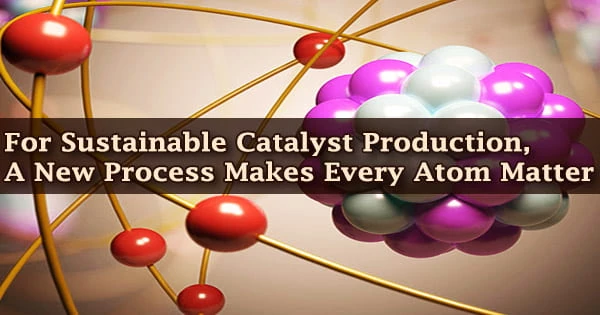Scientists have developed a novel approach to breakbulk metal into atoms in order to create heterogeneous catalysts with no chemical waste, which will lead to new sustainable ways of manufacturing and using molecules that are atom-efficient.
Researchers from the University of Nottingham have shown that “naked” Pt atoms may be disseminated directly onto powder supports by separating bulk metal to atoms at a record-breaking rate of four and a half thousand trillion atoms per second (4.5 × 1015 atom/s) using magnetron sputtering.
The approach is scalable and solvent-free, paving the way for the development of useful catalyst materials including Pt atoms supported on powder particles. The research was published in the peer-reviewed Journal of Materials Chemistry A of the Royal Society of Chemistry.
Catalysts are used in roughly 80% of industrial chemical processes that produce the most important ingredients in our economy, ranging from materials (like polymers) and pharmaceuticals to agrochemicals like fertilizers and crop protection.
Because of the enormous demand for catalysts, global stocks of numerous essential metals, such as gold, platinum, and palladium, are quickly depleting.
It is critical to utilize each and every atom to its full potential in order to protect these metal supplies. One of the most effective ways for increasing the active surface area available for catalysis is atomic dispersion of metals in support materials.
At the heart of our method, individual metal atoms are knocked out of the bulk metal one by one by a fast beam of argon ions creating a shower of metal atoms raining onto the support material. The desired quantity of metal atoms can be generated on demand within seconds, but controlling their distribution on the powder support still remains a challenge. We are making good progress with designing innovative mixing systems for magnetron sputtering process and filed for a patent earlier this year.
Dr. Jesum Alves Fernandes
When compared to metal nanoparticles, the characteristics of metal atoms can alter dramatically, resulting in new phenomena that are otherwise unavailable at the macroscale. The manufacture of atomically distributed metal catalysts has traditionally relied on either wet chemistry (i.e. metal salt ereduction) or atomic layer deposition (ALD).
Because these processes involve numerous steps and/or high temperatures, generate huge volumes of chemical waste, and are not easily generalizable across supports and metal catalysts, industrial scale-up is problematic.
This new study shows how magnetron sputtering may produce atomically dispersed metals in any support material in a sustainable and scalable manner, including platinum, cobalt, and nickel in the current study.
This approach has been utilized to manufacture atomically scattered metal catalysts in the glasscoating and semiconductor industries, and it has recently been adapted to make atomically dispersed metal catalysts.
The researchers employed analytical and imaging tools to show that the Pt atoms were atomically scattered across the whole surface of the powder support, and then used this catalyst to produce hydrogen photocatalytically.
Dr. Jesum Alves Fernandes, Assistant Professor in Chemistry at University of Nottingham, led the research, he said:
“At the heart of our method, individual metal atoms are knocked out of the bulk metal one by one by a fast beam of argon ions creating a shower of metal atoms raining onto the support material. The desired quantity of metal atoms can be generated on demand within seconds, but controlling their distribution on the powder support still remains a challenge. We are making good progress with designing innovative mixing systems for magnetron sputtering process and filed for a patent earlier this year.”
The University, in collaboration with the Universities of Cardiff, Birmingham, and Cambridge, is leading a large-scale interdisciplinary project called “Metal Atoms on Surfaces and Interfaces (MASI) for Sustainable Future,” which was launched in August 2021 and is funded by the Engineering & Physical Sciences Research Council (EPSRC).





